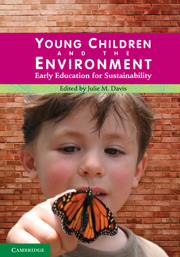Introduction
Summary
This is not a book about the perils of global warming and its impact on children, although climate change provides an impetus. Nor is it a response to environmental issues that shifts responsibilities from adults to children, asking them to fix what we leave behind. Instead, it is a book of positive ideas and actions that shows what early childhood educational communities can do when children, teachers and parents work together to address, arguably, one of the most serious issues of our time. It is about what early childhood education – and specifically, early childhood teacher education – can and must do to play its part in helping societies move towards sustainable living. It is about the emerging field of early childhood education for sustainability (ECEfS).
WHAT URGENCY?
Life on Earth is at a critical time. While global warming has captured media headlines, the bigger issue is that humans are not living within the Earth's capacity to provide clean air, clean and adequate water supplies, fertile soils, productive oceans and ongoing resources for the world's human population – now over 6.6 billion – and for the millions of non-human species. As the health of global ecosystems and the health of human populations are inextricably linked, the need for fundamental changes in how humans live is becoming difficult to ignore. The crisis in the world's financial markets (made evident in August 2008) demonstrates what happens when we live on borrowed capital.
- Type
- Chapter
- Information
- Young Children and the EnvironmentEarly Education for Sustainability, pp. 1 - 18Publisher: Cambridge University PressPrint publication year: 2010
References
- 3
- Cited by



